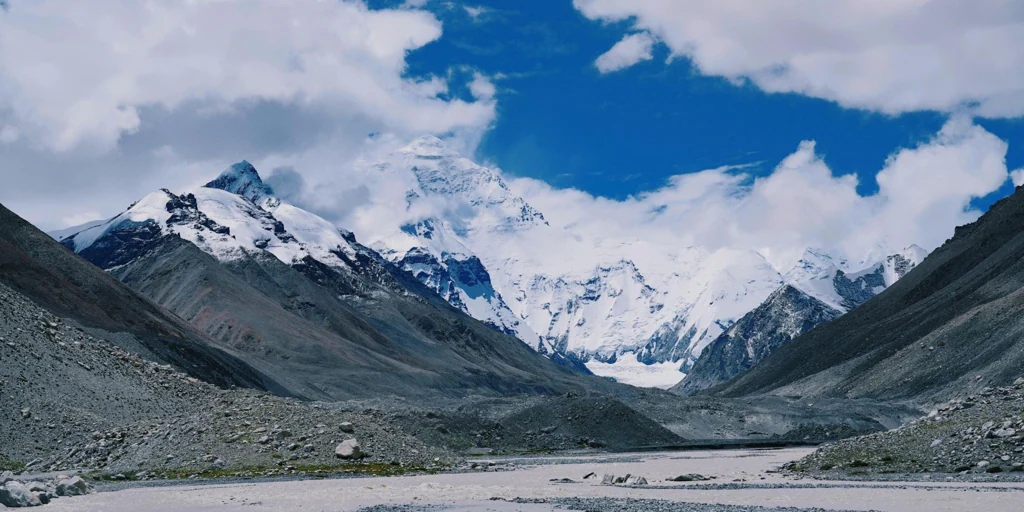We call it Everest, in Tibet they refer to it as Chomolungma and in Nepal as Sagarmth. But in any language, with its 8,843 meters, it is the highest mountain in the world. And not only that, but it continues to grow, which it also does at an abnormally high rate in relation to the other mountains in the Himalayan mountain range. Everest, in fact, surpasses the second highest peak, K2, by about 250 meters, and that is almost double the 120 meter difference between K2 and the next two in the height ranking, Kangchenjunga and the Lhotse. That is to say, there must be a mechanism, other than the ongoing regional tectonics, that is driving this excess growth.
Now, a team of researchers from the China University of Geosciences and University College London has managed to find out what that mechanism is: erosion caused by a river network that is about 75 km away and that carries tens of thousands of years digging a gorge. The loss of that land mass is ‘pushing’ the mountain up, causing it to rise about 2 mm per year. In total, scientists say, Everest has increased its height by between 15 and 50 meters in the last 89,000 years. The study has just been published in ‘Nature Geoscience’.
Pushing from below
According to the researchers, a significant part of this anomaly can be explained by a lifting force caused by the pressure of the mantle, beneath the Earth’s crust, after a nearby river eroded a considerable amount of rocks and soil. This is an effect called ‘isostatic rebound’, where a section of crust that is losing mass flexes and ‘floats’ upward because the intense pressure of the liquid mantle below is greater, after mass loss, than the force of gravity.
This is a gradual process, usually only a few millimeters a year, but over geological time periods it can make a significant difference to the Earth’s surface. In the case of Everest, that difference is an ‘extra’ elevation, between 15 and 50 meters in the last 89,000 years, since the nearby Arun River merged with the adjacent Kosi River network.
Mount Everest – explains Adam Smith, from University College London and co-author of the article – is an extraordinary mountain of myths and legends, and it continues to grow. Our research shows that as the nearby river system deepens, the loss of material causes the mountain to rise even higher.
Since 89,000 years ago
Today the Arun River flows east of Mount Everest and merges downstream with the larger Kosi river system. For millennia, the Arun has carved a major gorge, carrying billions of tons of earth and sediment. By looking at erosion rates of the Arun River, the Kosi and other rivers in the region, the researchers were able to determine that about 89,000 years ago the Arun River joined and merged with the Kosi network, a process called ‘drainage piracy’. In doing so, more water was channeled through the Kosi, increasing its erosive power and carrying with it more soil and sediment from the landscape. Something that would trigger a greater rate of elevation, pushing the mountain peaks higher and higher.
For Jin-Gen dai, from the China University of Geosciences and also co-author of the article, there is an interesting river system in the Everest region. The Arun River, upstream, flows eastwards at high altitudes in a flat valley. It then turns abruptly south like the Kosi River, dropping in elevation and becoming steeper. This unique topography, indicative of an unstable state, is likely related to Everest’s extreme height.
Neighboring peaks also grow
The researchers found that the uplift is not limited to just Everest, but also affects neighboring peaks, including Lhotse and Makalu, which are the fourth and fifth highest peaks.
of the world. According to the study, isostatic rebound increases the heights of these peaks by a similar amount to that of Everest, although Makalu, located closer to the Arun River, would be experiencing a slightly higher rate of rise.
Mount Everest and its neighboring peaks – says Matthew Fox, another member of the team – are growing because isostatic rebound raises them faster than erosion wears them down. We can see them growing about two millimeters a year using GPS instruments and we now better understand what drives this growth.
For Xu Han, lead author of the paper, the changing height of Mount Everest really highlights the dynamic nature of the Earth’s surface. The interaction between erosion from the Arun River and the upward pressure of the Earth’s mantle gives Mount Everest a boost, pushing it higher than it would otherwise be.

